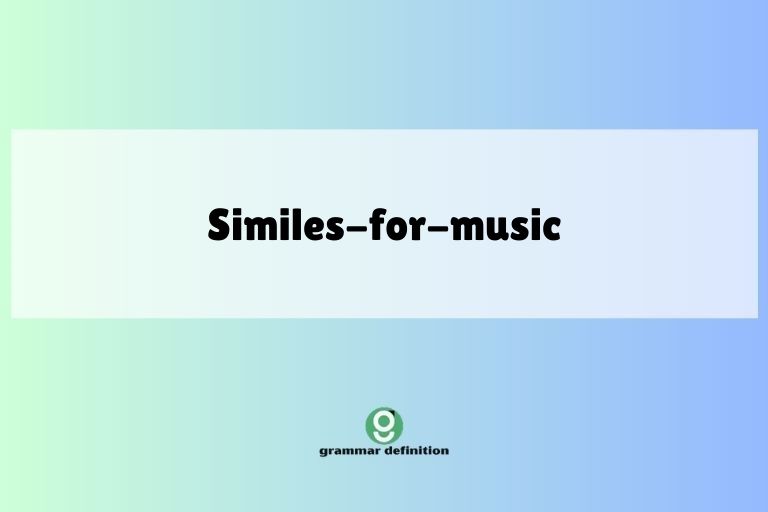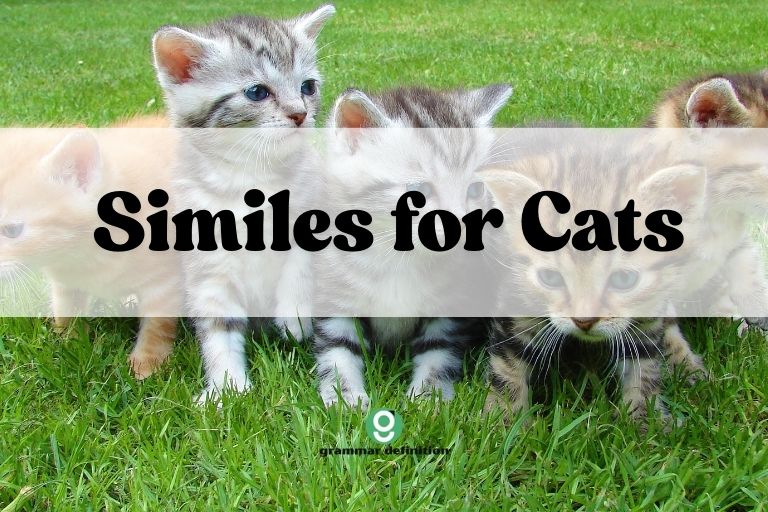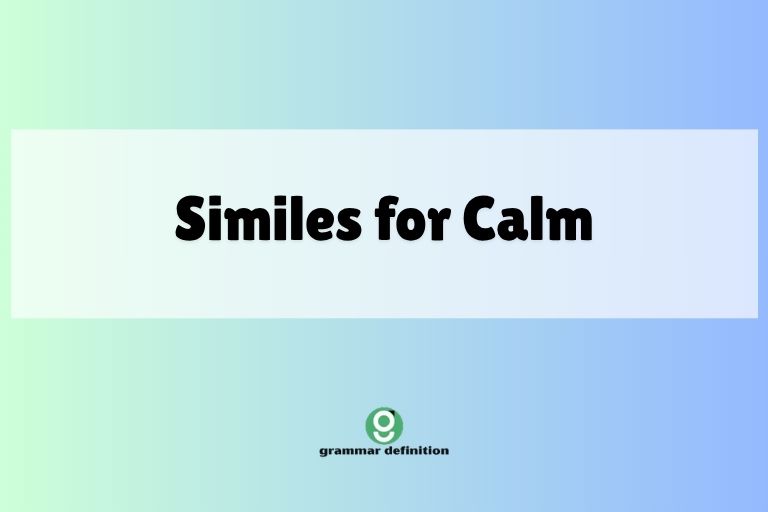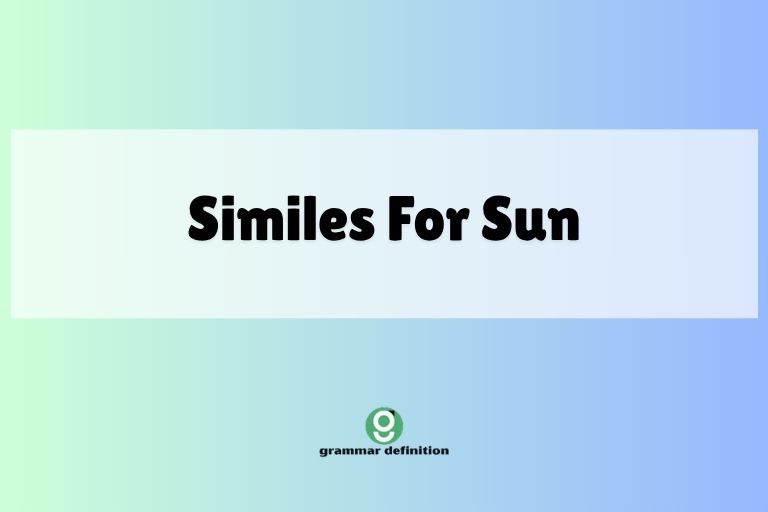Similes for Freedom: Unleashing Grammatical Creativity
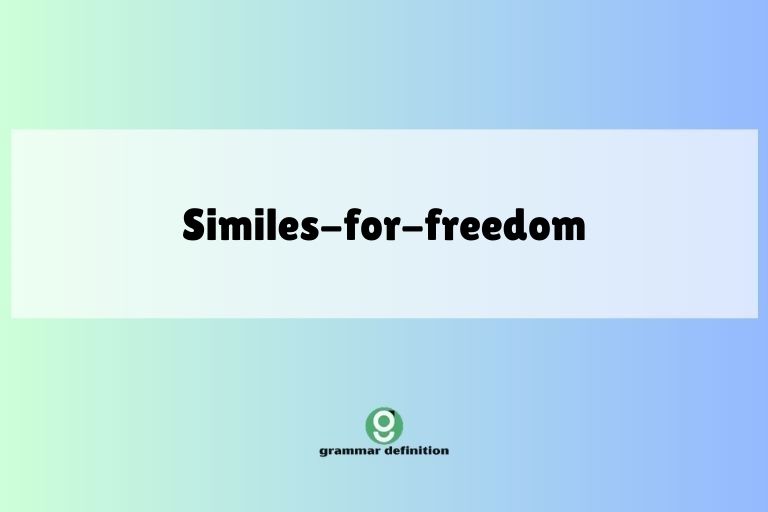
Understanding similes is crucial for enhancing descriptive language and adding depth to writing. Similes, by comparing two unlike things using ‘like’ or ‘as,’ enable writers to paint vivid pictures and convey complex ideas in an accessible way.
This article will delve into the world of similes, particularly focusing on those related to the concept of freedom, exploring their structure, usage, and impact. This guide is perfect for students, writers, and English language learners looking to enrich their vocabulary and master the art of figurative language.
This article will provide a comprehensive overview of similes, focusing on similes related to freedom. We will explore the definition, structure, and types of similes, and provide numerous examples to illustrate their use.
Additionally, we will address common mistakes, offer practice exercises, and delve into advanced topics to help you master this essential aspect of English grammar.
Table of Contents
- Introduction
- Definition of Similes
- Structural Breakdown of Similes
- Types of Similes
- Examples of Similes for Freedom
- Usage Rules for Similes
- Common Mistakes with Similes
- Practice Exercises
- Advanced Topics in Similes
- Frequently Asked Questions (FAQ)
- Conclusion
Definition of Similes
A simile is a figure of speech that compares two unlike things using the words “like” or “as.” The purpose of a simile is to create a vivid image in the reader’s mind by highlighting a shared characteristic between the two things being compared. Similes are an essential tool in descriptive writing, allowing authors to express complex ideas in a relatable and engaging manner.
Similes are classified as a type of figurative language, specifically under the umbrella of comparisons. Their primary function is to enhance understanding and create imagery.
Similes can be found in various contexts, from literature and poetry to everyday conversation and advertising. They add color and depth to language, making it more expressive and memorable.
Structural Breakdown of Similes
The basic structure of a simile consists of three key components: the subject (the thing being described), the linking word (“like” or “as”), and the object of comparison (the thing the subject is being compared to). Understanding this structure is crucial for both creating and interpreting similes effectively.
The pattern is simple: Subject + Linking Word (like/as) + Object of Comparison. For example, in the simile “Free as a bird,” “freedom” is the subject, “as” is the linking word, and “a bird” is the object of comparison.
This structure allows for a clear and concise comparison, highlighting the shared quality of being unconfined.
Types of Similes
While all similes share the same basic structure, they can be categorized based on the type of comparison they make or the effect they create. Here are a few common types:
Descriptive Similes
Descriptive similes are used to provide a vivid description of something. They focus on physical attributes, behaviors, or qualities.
Emotional Similes
Emotional similes evoke a specific emotion or feeling by comparing the subject to something that embodies that emotion.
Explanatory Similes
Explanatory similes clarify a complex idea by comparing it to something simpler and more relatable.
Hyperbolic Similes
Hyperbolic similes use exaggeration to emphasize a particular quality or characteristic.
Examples of Similes for Freedom
Let’s explore a wide range of similes that evoke the concept of freedom. These examples are categorized to illustrate different aspects and nuances of freedom.
Similes Describing Freedom’s State
These similes describe the state of being free, focusing on the feeling and experience of liberation.
| Simile | Explanation |
|---|---|
| Free as a bird | Highlights the unconfined nature of birds, suggesting unrestricted movement and independence. |
| Free as the wind | Emphasizes the unrestricted and unpredictable nature of the wind, symbolizing boundless liberty. |
| Free as a river flowing to the sea | Compares freedom to the natural and unstoppable flow of a river, signifying a journey without constraints. |
| Free like a butterfly emerging from its cocoon | Symbolizes the transformative aspect of freedom, representing release and new beginnings. |
| Free as the open sky | Represents limitless possibilities and the absence of barriers, conveying a sense of vast and unrestricted freedom. |
| Free as a child’s laughter | Captures the pure, uninhibited joy and spontaneity associated with freedom. |
| Free as a released prisoner | Illustrates the relief and exhilaration of escaping confinement and regaining liberty. |
| Free like a balloon floating away | Conveys a sense of lightness and detachment, symbolizing the release from burdens and responsibilities. |
| Free as a wildflower in a field | Represents natural, untamed beauty and the ability to thrive without external control. |
| Free as thought | Emphasizes the unlimited and unrestricted nature of the mind, suggesting the power of independent thinking. |
| Free like a rolling stone | Suggests a life of constant movement and independence, unburdened by attachments or responsibilities. |
| Free as a blank canvas | Represents limitless potential and the opportunity to create one’s own destiny without pre-existing constraints. |
| Free like a ship sailing on the open ocean | Conveys a sense of adventure and exploration, symbolizing the ability to navigate life without boundaries. |
| Free as the air we breathe | Highlights the essential and unrestricted nature of freedom, suggesting it is a fundamental human right. |
| Free like a bird in flight | Reinforces the image of unrestricted movement and independence, emphasizing the joy of liberation. |
| Free as the morning sun | Symbolizes hope, renewal, and the promise of a new day without the shadows of the past. |
| Free like a river finding its course | Represents the natural and unforced path to self-discovery and fulfillment. |
| Free as a spirit unburdened | Captures the feeling of emotional and spiritual release, suggesting freedom from inner turmoil and regret. |
| Free like a book uncensored | Emphasizes the importance of intellectual freedom and the ability to express ideas without fear of reprisal. |
| Free as a dance without rules | Symbolizes the joy of self-expression and the ability to move freely without limitations. |
| Free as a voice unafraid | Represents the power of speaking truth to power and the courage to stand up for one’s beliefs. |
| Free like a song unsung | Conveys the potential for creativity and self-expression that lies dormant within each individual. |
| Free as a dream unfiltered | Emphasizes the boundless possibilities of the imagination and the ability to envision a better future. |
| Free like a heart unfettered | Symbolizes the release from emotional constraints and the ability to love and connect without fear. |
| Free as a mind unclouded | Represents clarity of thought and the ability to make informed decisions without bias or prejudice. |
Similes Describing the Pursuit of Freedom
These similes focus on the act of seeking and achieving freedom, highlighting the struggles and triumphs involved.
| Simile | Explanation |
|---|---|
| Seeking freedom like a plant reaching for sunlight | Illustrates the natural and persistent desire for freedom, driven by an innate need for growth and fulfillment. |
| Fighting for freedom like a lion defending its territory | Emphasizes the fierce determination and protective instinct involved in the struggle for liberty. |
| Grasping freedom like a drowning person reaching for air | Conveys the desperation and urgency of seeking liberation from oppressive circumstances. |
| Protecting freedom like a mother guarding her child | Highlights the unwavering commitment and selflessness required to preserve liberty for future generations. |
| Achieving freedom like a climber reaching the summit | Symbolizes the hard work, perseverance, and ultimate triumph involved in overcoming obstacles to achieve liberation. |
| Yearning for freedom like a prisoner longing for release | Expresses the deep and constant desire for liberation from confinement and oppression. |
| Striving for freedom like a river carving its path through stone | Conveys the relentless and determined effort required to overcome obstacles and achieve liberty. |
| Seeking freedom like a lost traveler searching for home | Illustrates the sense of longing and the desire for belonging that drives the pursuit of liberation. |
| Fighting for freedom like a warrior defending their homeland | Emphasizes the courage, sacrifice, and sense of duty involved in protecting one’s liberty. |
| Embracing freedom like a long-awaited reunion | Symbolizes the joy, relief, and sense of completeness that comes with achieving liberation. |
| Pursuing freedom like a scholar seeking knowledge | Highlights the intellectual curiosity and the desire for enlightenment that drives the quest for liberation. |
| Fighting for freedom like a doctor battling a disease | Conveys the sense of urgency and the commitment to eradicating oppression and injustice. |
| Defending freedom like a fortress protecting its inhabitants | Emphasizes the importance of vigilance and the need to safeguard liberty from external threats. |
| Seeking freedom like a plant turning towards the light | Illustrates the natural and instinctive desire for growth, opportunity, and self-expression. |
| Fighting for freedom like a small bird challenging a hawk | Conveys the courage and determination required to stand up against powerful oppressors. |
| Clinging to freedom like a survivor holding onto a lifeline | Emphasizes the preciousness of liberty and the unwavering commitment to preserving it. |
| Protecting freedom like a gardener tending to a delicate flower | Highlights the need for care, attention, and nurturing to ensure the continued flourishing of liberty. |
| Achieving freedom like a phoenix rising from the ashes | Symbolizes the transformative power of liberation and the ability to overcome adversity and emerge stronger. |
| Yearning for freedom like a sailor longing for the shore | Expresses the deep and persistent desire for stability, security, and a sense of belonging. |
| Striving for freedom like a river pushing through a dam | Conveys the relentless and determined effort required to overcome obstacles and achieve liberation. |
| Seeking freedom like a bee drawn to a flower | Illustrates the natural and instinctive desire for nourishment, growth, and self-fulfillment. |
| Fighting for freedom like a writer wielding a pen | Emphasizes the power of words and ideas to challenge oppression and inspire change. |
| Embracing freedom like a child receiving a gift | Symbolizes the joy, gratitude, and sense of wonder that comes with achieving liberation. |
| Pursuing freedom like an artist seeking inspiration | Highlights the creative spark and the desire for self-expression that drives the quest for liberation. |
Similes Describing the Impact of Freedom
These similes describe the transformative effects of freedom on individuals and societies.
| Simile | Explanation |
|---|---|
| Freedom empowering like a rising tide | Illustrates the overwhelming and transformative power of liberation, lifting individuals and communities to new heights. |
| Freedom enlightening like the dawn after a long night | Symbolizes the clarity, hope, and new perspectives that emerge with the arrival of liberty. |
| Freedom liberating like breaking chains | Conveys the sense of release and the removal of constraints that comes with achieving liberation. |
| Freedom transforming like a caterpillar into a butterfly | Highlights the profound and positive changes that occur when individuals are freed from oppression. |
| Freedom inspiring like a beacon in the darkness | Emphasizes the hope, courage, and motivation that freedom provides to those who are struggling for liberation. |
| Freedom healing like a balm on a wound | Symbolizes the restorative power of liberty, mending the damage caused by oppression and injustice. |
| Freedom strengthening like a muscle being exercised | Conveys the idea that liberty must be actively used and defended to maintain its strength and vitality. |
| Freedom unifying like a common language | Emphasizes the ability of liberty to bring people together, transcending differences and fostering understanding. |
| Freedom creating like a seed sprouting into a tree | Illustrates the potential for growth, development, and innovation that is unlocked by liberation. |
| Freedom empowering like a voice being heard | Symbolizes the importance of self-expression and the ability to participate in shaping one’s own destiny. |
| Freedom enlightening like a book being read | Conveys the idea that liberty opens up new avenues for learning, understanding, and personal growth. |
| Freedom liberating like a bird escaping its cage | Emphasizes the sense of relief and the joy of escaping confinement and oppression. |
| Freedom transforming like a desert blooming after rain | Highlights the ability of liberty to bring life, beauty, and prosperity to previously barren or oppressed areas. |
| Freedom inspiring like a song being sung | Symbolizes the hope, courage, and motivation that freedom provides to those who are struggling for liberation. |
| Freedom healing like a sunrise after a storm | Conveys the restorative power of liberty, bringing peace, hope, and renewal after periods of hardship. |
| Freedom strengthening like a tree weathering a storm | Emphasizes the resilience and the ability to withstand challenges that liberty provides. |
| Freedom unifying like a shared dream | Illustrates the ability of liberty to bring people together, fostering a sense of common purpose and shared identity. |
| Freedom creating like a river carving a canyon | Symbolizes the power of liberation to shape and reshape the world, creating new possibilities and opportunities. |
| Freedom empowering like a vote being cast | Conveys the importance of participation, representation, and the ability to influence the decisions that affect one’s life. |
| Freedom enlightening like a light shining in the darkness | Highlights the ability of liberty to dispel ignorance, prejudice, and oppression. |
| Freedom liberating like a weight being lifted | Emphasizes the sense of relief and the removal of burdens that comes with achieving liberation. |
| Freedom transforming like a seed growing into a flower | Illustrates the potential for growth, beauty, and fulfillment that is unlocked by liberation. |
| Freedom inspiring like a story being told | Symbolizes the hope, courage, and motivation that freedom provides to those who are struggling for liberation. |
| Freedom healing like a loving embrace | Conveys the restorative power of liberty, mending the emotional and psychological wounds caused by oppression. |
| Freedom strengthening like a community working together | Emphasizes the importance of solidarity, cooperation, and collective action in preserving and promoting liberty. |
Usage Rules for Similes
Using similes effectively requires adherence to certain rules. Primarily, ensure that the comparison is logical and creates a clear image.
The objects being compared should share a recognizable quality, even if they are otherwise dissimilar. Avoid clichés, as they can weaken the impact of your writing.
- Use “like” or “as”: These are the standard linking words for similes.
- Ensure a logical comparison: The comparison should make sense and highlight a shared quality.
- Avoid clichés: Overused similes lose their impact.
- Be specific: The more specific the comparison, the more vivid the image.
- Consider the context: Ensure the simile is appropriate for the tone and style of your writing.
Common Mistakes with Similes
Several common mistakes can undermine the effectiveness of similes. One frequent error is confusing similes with metaphors.
While both are figures of speech that make comparisons, a simile uses “like” or “as,” whereas a metaphor implies the comparison directly.
| Mistake | Incorrect Example | Correct Example |
|---|---|---|
| Confusing simile with metaphor | Freedom is a bird. | Freedom is like a bird. |
| Using illogical comparisons | Freedom is like a rock. | Freedom is like a boundless sky. |
| Overusing clichés | Free as a bird. | Free as a river carving its own path. |
| Being too vague | Freedom is like something good. | Freedom is like a breath of fresh air. |
Practice Exercises
Test your understanding of similes with these exercises. Identify the similes in the sentences below and then create your own similes related to freedom.
Exercise 1: Identifying Similes
Identify the similes in the following sentences.
| Question | Answer |
|---|---|
| 1. Her spirit was as free as the wind. | as free as the wind |
| 2. The prisoner yearned for freedom. | (No simile present) |
| 3. His heart soared like an eagle when he was released. | soared like an eagle |
| 4. They fought for freedom with unwavering determination. | (No simile present) |
| 5. Freedom is a precious gift. | (No simile present) |
| 6. The country was as free as a newborn nation. | as free as a newborn nation |
| 7. She danced with a joy that was like sunshine. | that was like sunshine |
| 8. The protesters marched for their rights. | (No simile present) |
| 9. His words were as powerful as a thunderclap. | as powerful as a thunderclap |
| 10. The artist painted with unrestrained creativity. | (No simile present) |
Exercise 2: Creating Similes
Complete the following sentences with a simile related to freedom.
| Question | Possible Answer |
|---|---|
| 1. The feeling of liberation was ____________________. | like a weight lifted from my shoulders. |
| 2. A life without freedom is ____________________. | as bleak as a winter day without sun. |
| 3. The pursuit of freedom is ____________________. | like climbing a mountain with no top. |
| 4. The power of freedom is ____________________. | as strong as a river cutting through rock. |
| 5. The hope for freedom burned ____________________. | like a candle in the darkest night. |
| 6. The spirit of freedom is ____________________. | as resilient as a wildflower pushing through concrete. |
| 7. A society without freedom is ____________________. | like a garden without sunlight. |
| 8. The impact of freedom is ____________________. | as transformative as a chrysalis becoming a butterfly. |
| 9. The voice of freedom sounds ____________________. | like a clear bell ringing out across the land. |
| 10. The dream of freedom feels ____________________. | as vast as the open sky. |
Advanced Topics in Similes
For advanced learners, exploring the nuances of similes can involve analyzing their cultural and historical contexts. Similes can reflect societal values and beliefs, and their interpretation may vary across different cultures.
Additionally, advanced learners can experiment with creating original and complex similes that go beyond simple comparisons.
Advanced learners can also study the use of similes in literature, examining how different authors employ them to achieve specific effects. Understanding the rhetorical impact of similes can enhance both analytical and creative writing skills.
Furthermore, exploring the evolution of similes over time can provide insights into changing cultural perspectives.
Frequently Asked Questions (FAQ)
Here are some frequently asked questions about similes:
- What is the difference between a simile and a metaphor?
A simile compares two things using “like” or “as,” while a metaphor directly equates them without using those words. For example, “Freedom is like a bird” (simile) versus “Freedom is a bird” (metaphor). - Can a simile be a cliché?
Yes, if a simile is overused and has lost its impact, it becomes a cliché. It’s best to avoid clichés and try to create fresh, original comparisons. - How can I create effective similes?
To create effective similes, focus on finding a shared quality between two unlike things. Be specific and avoid vague comparisons. Consider the context and tone of your writing. - Why are similes important in writing?
Similes enhance descriptive language, add depth to writing, and help readers understand complex ideas by making relatable comparisons. - What are some common words used in similes?
The most common words used in similes are “like” and “as.” Other words that can be used to introduce comparisons include “than” and “resembles.” - Are similes only used in literature?
No, similes are used in various contexts, including everyday conversation, advertising, and speeches. They add color and expressiveness to language in any setting. - How do I avoid using clichés in my similes?
To avoid using clichés, try to think outside the box and come up with unique comparisons. Consider the specific qualities you want to highlight and find less common ways to express them. - Can a simile be used incorrectly?
Yes, a simile can be used incorrectly if the comparison is illogical or doesn’t make sense. Ensure that the two things being compared share a recognizable quality.
Conclusion
Mastering similes is an invaluable skill for anyone looking to enhance their writing and communication abilities. By understanding the structure, types, and usage rules of similes, you can effectively create vivid images, convey complex ideas, and add depth to your language.
Focusing on the concept of freedom, as explored in this article, provides a rich context for practicing and refining your simile skills.
Remember to avoid common mistakes, such as confusing similes with metaphors and using clichés. Practice creating your own similes, and pay attention to the context and tone of your writing.
With dedication and practice, you can unleash your creativity and master the art of using similes to express yourself with clarity and impact. Keep exploring the power of language, and let your words soar like a bird set free.


